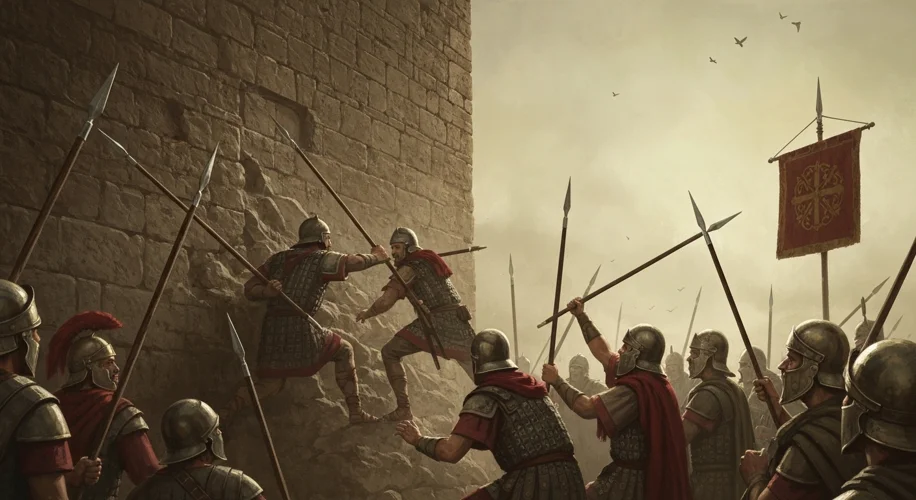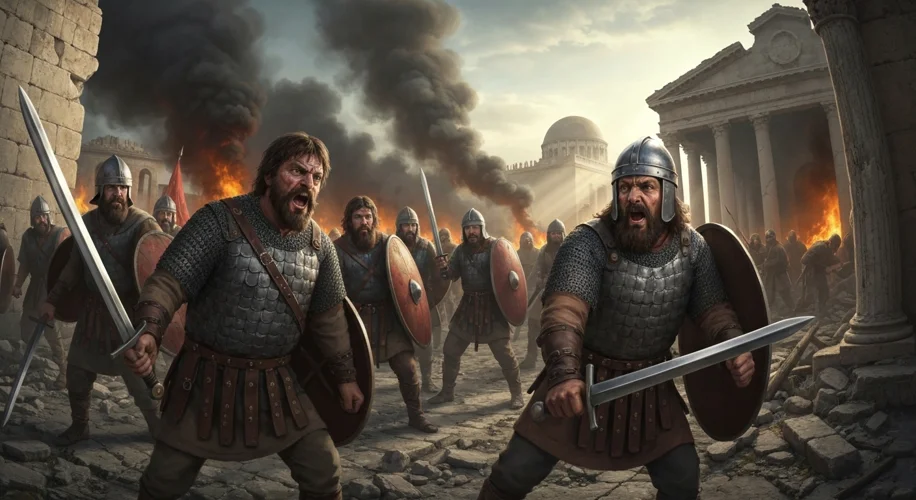The year is 410 AD. For over a thousand years, Rome had stood as the undisputed mistress of the Mediterranean world, a beacon of law, order, and power. Its legions had marched across continents, its emperors ruled vast territories, and its very name evoked an aura of invincibility. Yet, on this fateful day, the unthinkable happened. The Eternal City, the heart of a sprawling empire, was breached and left to the mercy of barbarian invaders.
For centuries, the Roman Empire had been a colossus, but even colossi can begin to crumble. Internal strife, economic woes, and the relentless pressure of migrating peoples on its borders had weakened its once formidable defenses. Among these migrating peoples were the Visigoths, a Germanic tribe who, under their ambitious leader Alaric I, had carved out a kingdom for themselves within the empire’s boundaries.
Alaric was no mere raider; he was a skilled warrior and a shrewd politician who felt wronged by the Roman authorities. He had served in the Roman army, even commanding Gothic troops within its ranks, but his demands for recognition and land had been met with resistance and broken promises by successive emperors. Frustrated and angered, Alaric turned his gaze toward the ultimate prize: Rome itself.
His previous attempts to negotiate had failed, and in 410 AD, he found himself at the gates of the city. This wasn’t the Rome of Augustus or Trajan, but a city that had already moved its capital to Ravenna, a more defensible location. Nevertheless, Rome still held immense symbolic power and wealth. The citizens, accustomed to centuries of peace within their formidable walls, were ill-prepared for the terror that was about to unfold.

The city’s defenses, while still substantial, were not insurmountable for a determined force. After a prolonged siege, during which disease and starvation gripped the Roman populace, Alaric’s forces found a way in. Some accounts suggest a betrayal from within, with slaves opening the Salarian Gate. Others speak of the Visigoths overpowering the guards.
Once inside, the Visigoths were unleashed upon the city for three grueling days. It wasn’t a complete annihilation – Alaric, a Christian himself, had given orders to spare the lives of those who sought sanctuary in churches, most notably St. Peter’s Basilica and St. Paul’s Outside the Walls. However, the sack was thorough. Palaces were looted, homes were ransacked, and treasures were carried away. The once-proud streets ran with fear and the spoils of war.
The news of Rome’s fall reverberated across the empire like a death knell. For the first time in nearly 800 years, the city that had dominated the known world had been captured by a foreign enemy. The psychological impact was immense. The very symbol of Western civilization had been violated.
Think of Saint Jerome, the great scholar and translator of the Bible, who was living in Bethlehem at the time. His letters paint a vivid picture of the despair and shock. He wrote of how the world seemed to have perished with the fall of Rome, how a terrible silence had fallen upon the earth. The event fueled Christian apologetics, with some arguing it was divine punishment for Rome’s pagan past, while others, like Augustine of Hippo, used it to articulate his concept of the City of God, arguing that true citizenship and security lay not in earthly empires, but in the heavenly kingdom.
The immediate consequences were significant, though perhaps not as catastrophic as some contemporaries feared. The Visigoths, after their plunder, left Rome and moved on, eventually establishing a kingdom in Gaul. While the city was undoubtedly damaged and its prestige tarnished, the administrative and military structures of the Western Roman Empire, though weakened, did not immediately collapse. However, the sack served as a powerful and undeniable symptom of the empire’s deeper maladies. It exposed the vulnerability of a state that had, for too long, relied on its past glories and internal decay had eroded its foundations.
The sack of Rome in 410 AD was not the sole cause of the Western Roman Empire’s eventual fall, which would occur nearly half a century later. However, it was a pivotal moment, a stark reminder that even the seemingly invincible could be brought low. It marked a profound shift in the perception of Roman power and ushered in an era of greater instability and fragmentation. The memory of the Visigoths’ conquest of the Eternal City would linger for centuries, a potent symbol of change and the fragility of even the most enduring human creations, forever altering the course of Western history.

